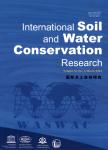Land use impact on clay dispersion/flocculation in irrigated and flooded vertisols from Northern Cameroon
作者机构:Institute of Agricultural Research for Development(IRAD)P.O.Box33MarouaCameroon Department of Earth SciencesFaculty of ScienceUniversity of MarouaP.O Box814MarouaCameroon Department of Earth SciencesFaculty of ScienceUniversity of Yaoundé1P.O Box812YaoundéCameroon Department of Earth SciencesFaculty of ScienceUniversity of NgaoundéréP.O Box454NgaoundéréCameroon
出 版 物:《International Soil and Water Conservation Research》 (国际水土保持研究(英文))
年 卷 期:2018年第6卷第3期
页 面:237-244页
核心收录:
学科分类:09[农学] 0903[农学-农业资源与环境] 090301[农学-土壤学]
主 题:Vertisols Clay dispersion Irrigation Land use North Cameroon
摘 要:Clay dispersion by water is important for soil and water conservation as well as for irrigation scheduling. In the present study, clay dispersion/flocculation of irrigated and flooded vertisols in North Cameroon was investigated using clay dispersion/stability indices. Nine vertisols topsoils (0–20 cm) samples were collected on different land use and their clay dispersion indices were assessed. Vertisols were acidic to slightly basic, with smectites as dominant clay mineral. The water dispersible clay (160–340 g kg-1), the dispersion ratio (0.55–0.79) and the clay dispersion ratio (0.48–0.83) were high in the studied vertisols while the clay flocculation index (0.17–0.54) and the clay aggregation (70–230 g kg-1) were low to moderate, indicating their high dispersion. Cropped vertisols displayed the higher amount of water dispersible clay while not cropped recorded the smaller amount. Concerning the cropped soils, irrigated vertisols displayed the highest clay dispersion indices suggesting that agricultural practices (irrigation) enhance clay dispersion. Globally, the clay dispersibility trend was: irrigated paddy ? rainy sorghum ? rainfed paddy ? dry-season sorghum ? not cropped. Statistical analyses revealed that amorphous Al, Na+ and electrical conductivity enhance clay dispersion while organic matter, nitrogen and Ca++ promote clay flocculation/aggregation. The overall findings emphasized that practices such as heavy tillage and irrigation induce clay dispersion. Minimum tillage, electrolytes concentration monitoring in irrigation water, irrigation scheduling based on soil moisture control, organic matter inputs and implementation of adapted dams are measures susceptible to limit their degradation through clay dispersion.



